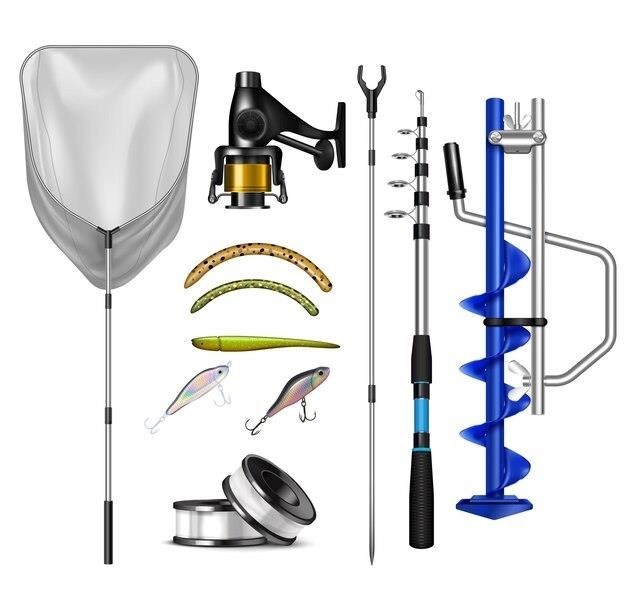Fishing Rod Guide Sizes⁚ A Comprehensive Guide
Choosing the right fishing rod guide size is crucial for optimal fishing performance. The size of the guide directly influences casting distance and accuracy‚ line flow‚ and overall fishing efficiency. This comprehensive guide explores the intricacies of fishing rod guide sizes‚ providing insights into selecting the ideal size for your specific needs.
Introduction
Fishing rod guides are small but essential components that play a vital role in the performance of your fishing rod. They are responsible for guiding the fishing line smoothly from the reel to the tip of the rod‚ influencing casting distance‚ accuracy‚ and overall fishing efficiency. Understanding the nuances of fishing rod guide sizes is crucial for serious anglers seeking to optimize their fishing experience. This comprehensive guide will delve into the world of fishing rod guide sizes‚ providing insights into their different types‚ materials‚ and how to choose the right size for your specific fishing style and target species.
We’ll explore the basics of rod guide design‚ the relationship between guide size and line diameter‚ and the factors to consider when selecting guide sizes‚ including fishing style‚ target fish‚ rod length‚ and rod action. This guide will equip you with the knowledge to make informed decisions when selecting the perfect fishing rod for your next angling adventure.
Understanding Rod Guide Basics
Fishing rod guides are small‚ cylindrical components attached to a fishing rod’s blank‚ serving a critical role in casting and reeling fishing line. Their primary function is to control and direct the fishing line as it moves from the reel through the tip of the rod. These guides are designed to minimize friction‚ allowing the line to flow smoothly and preventing it from catching or tangling‚ which can hinder casting distance and accuracy. They also help distribute the stress of a cast or a hooked fish along the rod’s length‚ preventing the rod from breaking.
The primary components of a fishing rod guide include the guide frame‚ an insert‚ the guide wrap‚ and the guide foot. The guide frame is the metal or composite structure that holds the insert and attaches to the rod blank. The insert is the smooth‚ hardened ring through which the line passes‚ reducing friction and wear. The guide wrap is the material that secures the guide to the rod blank‚ protecting the rod from damage and preventing the guide from loosening. The guide foot is the base of the guide that sits on the rod blank‚ providing stability and transferring the stress of the line to the rod.

Guide Size and Line Diameter
The size of the guide’s ring opening is directly related to the diameter of the fishing line you intend to use. A larger guide ring opening is necessary for thicker lines to pass through freely‚ minimizing friction and preventing line breakage. Conversely‚ a smaller guide ring opening is suitable for thinner lines‚ ensuring proper control and preventing the line from slipping through the guide. This relationship between guide size and line diameter is critical for optimal casting distance‚ accuracy‚ and overall fishing performance.
When choosing guide sizes‚ consider the line you’ll be using most often. For example‚ if you primarily fish with heavy lines‚ larger guide rings are essential for smooth line flow and reduced friction. If you mainly use lighter lines‚ smaller guide rings provide better control and prevent the line from slipping. The goal is to select guide sizes that match the line diameter‚ allowing the line to pass through the guides smoothly without excessive friction or wear.
Guide Size Measurement
Understanding how to measure fishing rod guide sizes is essential for selecting the appropriate guides for your rod building project or when choosing a pre-built rod. Guide sizes are typically measured in millimeters (mm) and refer to the diameter of the ring opening. The measurement is usually inscribed on the guide itself‚ but it’s always a good idea to double-check with a ruler or caliper for accuracy.
When measuring guide sizes‚ ensure you’re measuring the inner diameter of the ring opening‚ not the overall size of the guide frame. The inner diameter is the critical measurement that determines the line’s ability to pass through the guide smoothly. It’s also important to note that guide sizes can vary slightly between manufacturers‚ so always refer to the manufacturer’s specifications for accurate measurements.
Accurate guide size measurement is vital for proper rod performance. Incorrect guide sizes can lead to excessive friction‚ line wear‚ and reduced casting distance. By understanding how to measure guide sizes correctly‚ you can choose the right guides for your fishing needs‚ ensuring optimal performance and longevity of your fishing rod.
Guide Size Selection Based on Fishing Style
The type of fishing you engage in significantly influences the ideal guide size for your rod. Different fishing styles demand different line diameters and casting techniques‚ which necessitate specific guide sizes for optimal performance.
For instance‚ anglers pursuing light line techniques like finesse fishing or fly fishing often prefer smaller guide sizes. These smaller guides minimize friction‚ allowing for smoother line flow and greater control during delicate presentations. Conversely‚ anglers targeting larger fish with heavy lines‚ such as those engaging in saltwater trolling or big-game fishing‚ may opt for larger guides to accommodate thicker lines and reduce the risk of line breakage or damage.
Ultimately‚ the choice of guide size based on fishing style comes down to balancing line diameter‚ casting distance‚ and overall control; By carefully considering the specific demands of your chosen fishing style‚ you can select guide sizes that enhance your fishing experience and maximize your chances of success.
Guide Size Selection Based on Target Fish
The size and fighting strength of your target fish play a crucial role in determining the appropriate guide size for your fishing rod. Larger fish‚ especially those known for their powerful runs and strong resistance‚ require larger guides to accommodate thicker lines and minimize the risk of line breakage or damage.
For example‚ anglers targeting big-game species like marlin or tuna‚ often choose rods with larger guide sizes to manage the tremendous strain these fish exert. Conversely‚ those pursuing smaller‚ less powerful species like panfish or trout‚ may find that smaller guides provide sufficient line control and minimize friction‚ enhancing their casting accuracy and finesse.
By considering the size and fighting style of your target fish‚ you can select guide sizes that provide the necessary strength and durability to handle the challenges of landing your catch. This ensures both a successful fishing experience and the preservation of your rod and line.
Guide Size Selection Based on Rod Length
Rod length plays a significant role in determining the appropriate guide size. Longer rods generally require larger guides to accommodate the increased line flow and reduce friction. This is because longer rods create a greater distance for the line to travel from the reel to the tip‚ necessitating larger guides to prevent line snags and maintain smooth casting.
Conversely‚ shorter rods often benefit from smaller guides. These guides provide better line control and minimize the risk of line entanglement‚ especially when casting shorter distances. The smaller guide size also reduces the overall weight of the rod‚ making it easier to maneuver and cast for extended periods.
By considering the length of your rod‚ you can select guide sizes that optimize line flow‚ reduce friction‚ and enhance casting performance. This ensures that your rod is perfectly balanced for its intended purpose and delivers the desired casting distance and accuracy.
Guide Size Selection Based on Rod Action
Rod action‚ or how a rod bends under pressure‚ directly influences the appropriate guide size. A fast action rod‚ characterized by a stiff blank that bends primarily at the tip‚ often benefits from smaller guides. These guides provide precise line control and minimize line tangles during the casting process. The smaller size also helps maintain the rod’s fast action and responsiveness‚ allowing for quick hook sets and precise casts.
On the other hand‚ a slow action rod‚ with a more flexible blank that bends along its entire length‚ generally calls for larger guides. Larger guides accommodate the increased line flow and reduce friction associated with the slower action. This allows for smoother casting and reduces the strain on the line‚ particularly when fighting larger fish.
By carefully considering the action of your rod‚ you can select guide sizes that optimize line flow‚ minimize friction‚ and enhance the overall performance of your rod. This ensures that your rod functions optimally‚ regardless of your fishing style or target species.
Common Mistakes to Avoid When Choosing Guide Sizes
Choosing the wrong guide size can lead to suboptimal casting performance‚ increased line friction‚ and even damage to your rod. Here are some common mistakes to avoid⁚

• Ignoring line diameter⁚ Using guides that are too small for your line diameter can create excessive friction‚ leading to line breakage and reduced casting distance. Ensure your guides are large enough to accommodate your line comfortably.
• Overlooking rod action⁚ Failing to consider the rod’s action can result in mismatched guides. Fast action rods generally require smaller guides for precise line control‚ while slow action rods benefit from larger guides to accommodate the increased line flow.
• Choosing guides based solely on price⁚ While budget-friendly options exist‚ prioritize quality over cost. Inferior guide materials can lead to increased friction‚ reduced durability‚ and ultimately a less enjoyable fishing experience.
By avoiding these common mistakes‚ you can ensure that your chosen guide sizes complement your rod‚ enhancing its performance and your overall fishing experience.
Expert Advice for Optimal Rod Performance
To ensure optimal rod performance‚ consider these expert tips for selecting the right guide sizes⁚
• Consult with experienced rod builders⁚ Rod builders possess in-depth knowledge of guide sizing and can provide tailored advice based on your specific rod and fishing style. They can help you determine the ideal guide size for each section of your rod‚ ensuring optimal line flow and casting performance.
• Experiment with different guide sizes⁚ If you’re unsure about the ideal guide size‚ don’t hesitate to experiment. Try different size guides on your rod and observe how they affect casting distance‚ accuracy‚ and line flow. This hands-on approach can help you find the perfect combination for your needs.
• Consider the type of fishing⁚ The type of fishing you do will influence the optimal guide size. For example‚ heavy-duty saltwater fishing often requires larger guides to accommodate thicker lines‚ while finesse fishing techniques might benefit from smaller guides for increased line control.
By seeking expert advice and experimenting with different guide sizes‚ you can optimize your rod’s performance and maximize your enjoyment on the water.
Guide Size Chart
A guide size chart is a valuable tool for rod builders and anglers alike. It provides a visual reference for selecting the appropriate guide sizes for different line diameters and rod types. Here’s a simplified guide size chart that illustrates common guide sizes and their corresponding line diameters⁚
| Guide Size | Line Diameter (mm) |
|---|---|
| 6 | 0.35 ౼ 0.45 |
| 5 | 0.30 ౼ 0.40 |
| 4 | 0.25 ⸺ 0.35 |
| 3 | 0.20 ౼ 0.30 |
| 2 | 0.15 ⸺ 0.25 |
| 1 | 0.10 ౼ 0.20 |
| 1/0 | 0.05 ౼ 0.15 |
| 2/0 | 0.00 ౼ 0.10 |
It’s important to note that these are general guidelines‚ and the optimal guide size may vary depending on the specific rod‚ line type‚ and fishing style. Always consult with experienced rod builders or refer to reputable guide sizing charts for more detailed information.
Understanding fishing rod guide sizes is essential for any serious angler. By carefully selecting the appropriate guide sizes‚ you can optimize your casting distance and accuracy‚ minimize line friction‚ and enhance overall fishing performance. This comprehensive guide has provided a framework for making informed decisions about guide sizing‚ covering key factors such as line diameter‚ fishing style‚ target fish‚ and rod length and action.
Remember that proper guide selection is crucial for achieving the best results. Whether you are a seasoned angler or just starting out‚ investing time in understanding guide sizing will ultimately lead to a more enjoyable and successful fishing experience. Always consider your specific fishing needs‚ consult reputable resources‚ and don’t hesitate to seek advice from experienced rod builders or anglers for personalized guidance.



